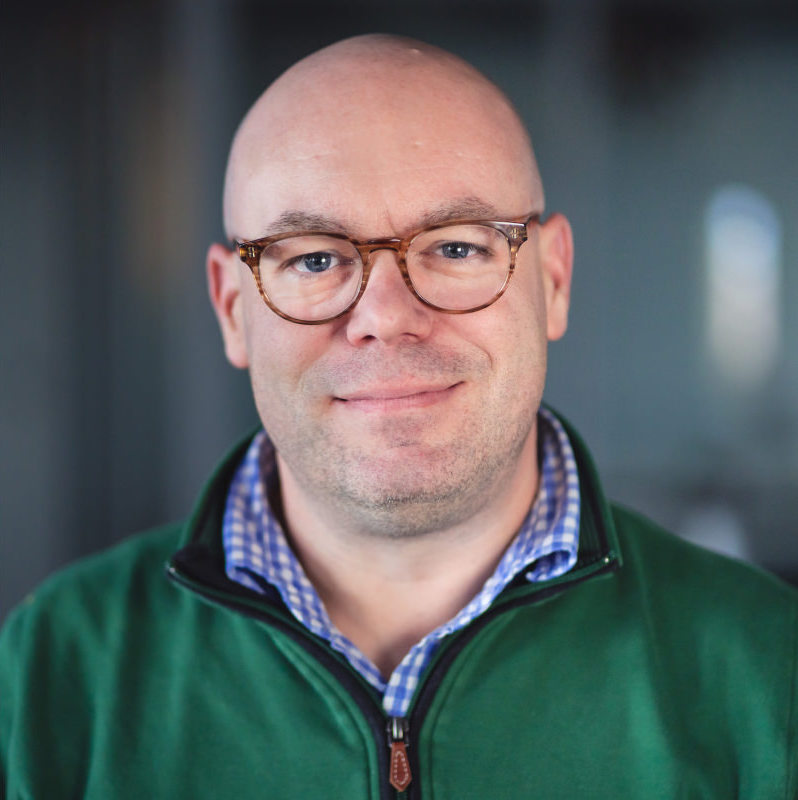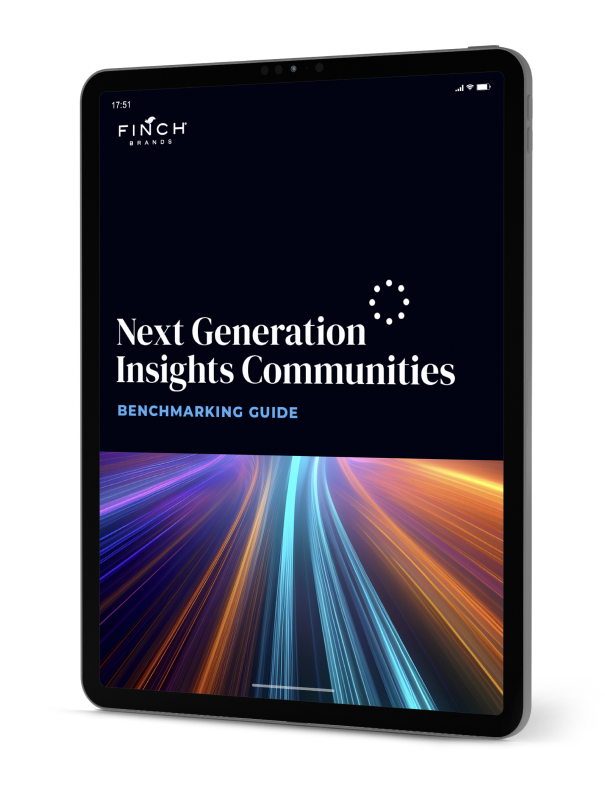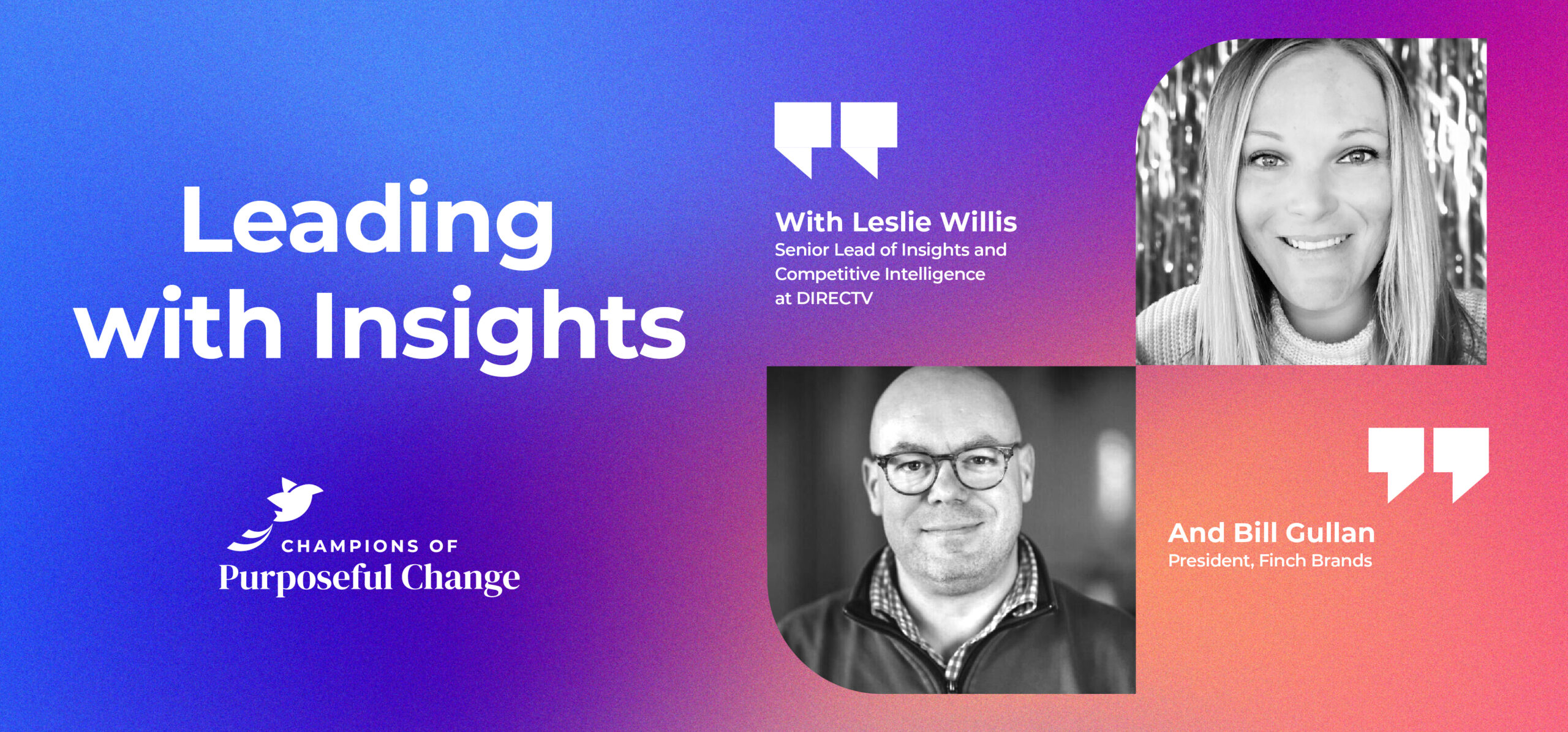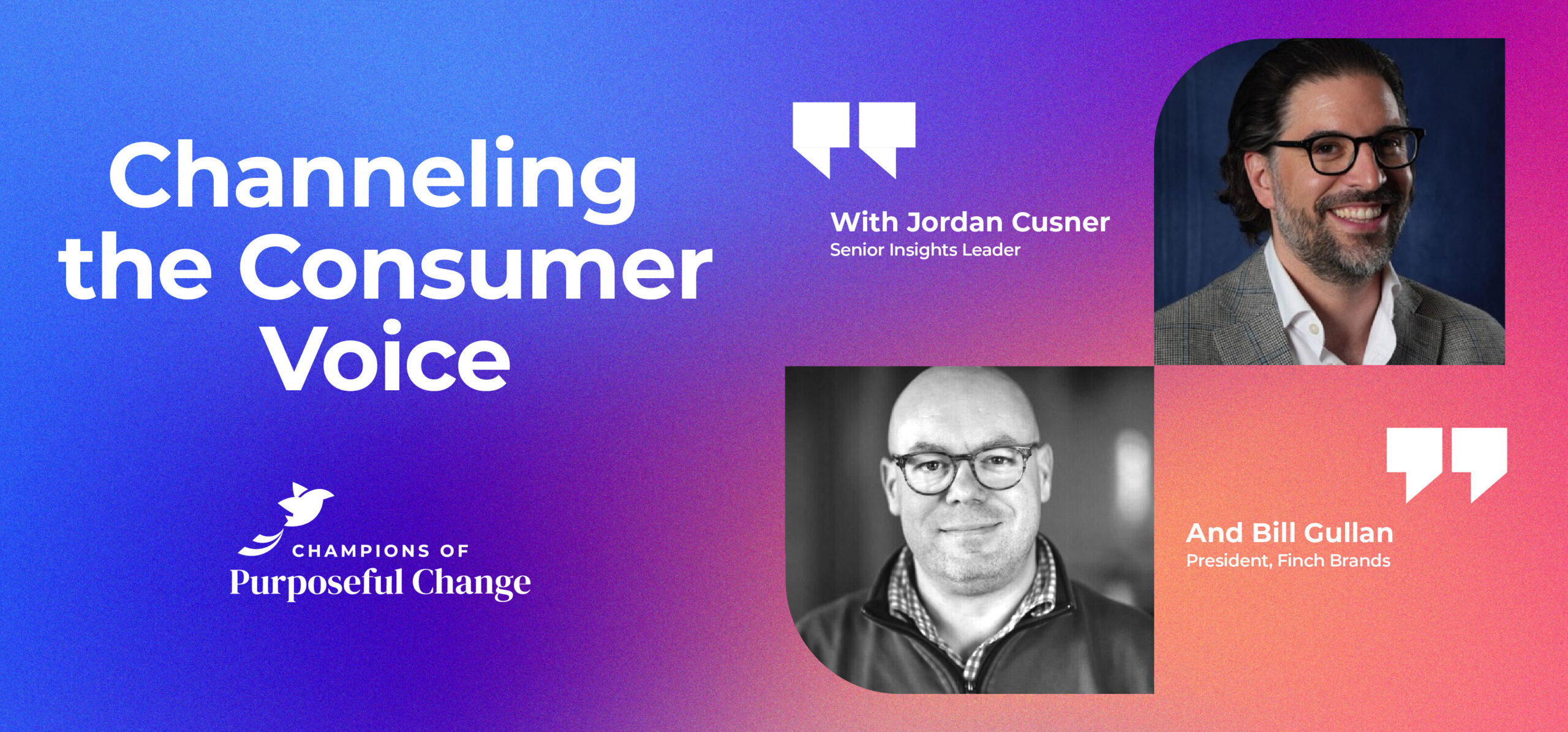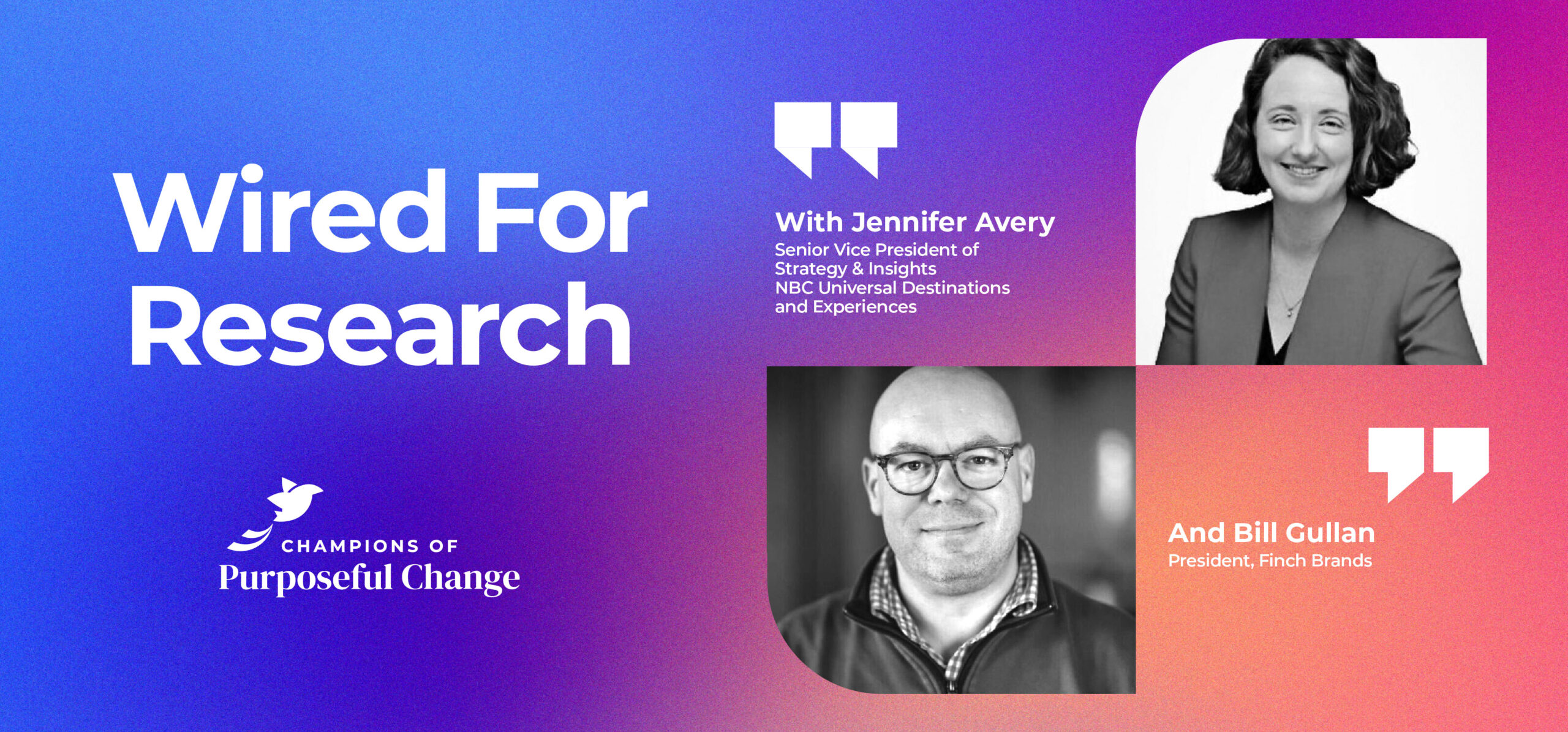Taking a Global Approach with Sonny Sethi of Zip Co
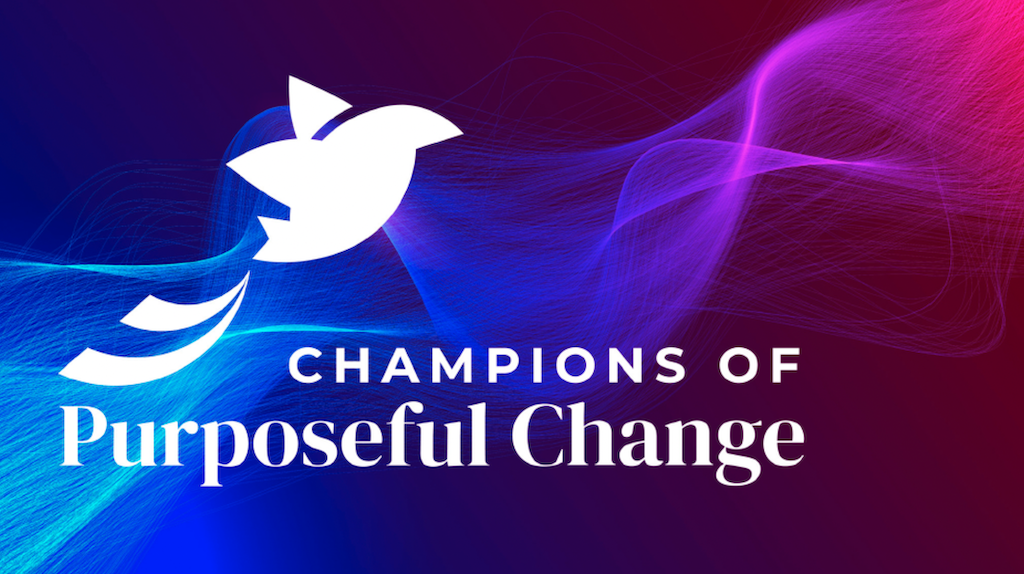
Join us to hear from Sonny Sethi, Senior Director of Marketing Research at Zip Co in Australia. Sonny shares stories and philosophies from his career across categories and markets – and his thoughts on where the industry is going. We hope you enjoy the show!
Bill Gullan:
Greetings, one and all, this is Champions of Purposeful Change. I’m Bill Gullan, President of Finch Brands. Thank you for coming and joining us today to hear from Sonny Sethi.
Sonny is the Senior director of marketing research at ZIP Co in Australia and as he will relate, a fascinating career, interesting journey with brands we know, brands we don’t, both on the supplier and the client side, including a lot of work across the globe, helping in Australia, New Zealand and well beyond, and now into the US with primary research and helping these organizations really channel the voice of the customer. So, Sonny is a strong advocate for putting the customer at the center of decision-making and learning for the purposes of internal impact and helping businesses and brands progress. Enjoy hearing from Sonny Sethi.
The wonders of technology have connected us across the world with Sonny Sethi from Zip Co in Sydney, Australia, and it’s a great pleasure to have you, Sonny. Nice to be together.
Sonny Sethi:
Pleasure to be here, Bill.
Bill Gullan:
Excellent, and let’s start where we normally do. Your career has been fascinating from my perspective, with stops in a variety of companies, some names many of our listeners would know and others not as yet. But could you take us through a little bit of what’s led you to this place and some of the twists and turns along the way?
Sonny Sethi:
Absolutely, Bill. I’m very passionate about research. My first job was in research going back 20 years now, where I started off as a really young researcher at a company called Research International, which is now Synovate. We used to do a lot of research calling up people on the phones and going and visiting people in their houses and asking about the chocolates and talking about the beers and the cars, and that just kind of caught my early interest early on. And then I jumped, started working for a company called Nielsen.
Bill Gullan:
Of course.
Sonny Sethi:
At that time I didn’t realize the scale of Nielsen, but again, as a young researcher, I just got to work on so many different brands, right from looking at brands like Nestlé and Kellogg’s and just working with a lot of retailers, working with a lot of petrol stations and just doing reports on new products and what the impact is with launching new products on their retail lines.
And I think at that point I realized that my career meant to be in the research space. I took on a really long stint at a company called Ipsos. So this time I knew where I’m going into. At Ipsos, I joined as a project manager, got promoted on a couple of instances, and that’s where I started to get my… I got my really strong base in working on a lot of big brands. So right on one end, working for a core hotels to Blackmores to a lot of energy brands, large telco brands, Kimberly-Clark, Nestlé, Samsung, and so on and so forth. So at that point I was doing end-to-end projects. I was speaking to clients as well. I was executing projects, qualitative, quantitative on a variety of products, testing new products. I think at that stage I must have tested at least 150, 200 new products. So, I was already doing the work in the innovation space, testing new products, looking at what makes something successful to launch and to scale up.
At that point I wanted to move across because when you’re working on the agency side, you don’t know what actually happens after you deliver on a project, right?
Bill Gullan:
Right, right.
Sonny Sethi:
You just know it through what you actually read in the press. So I took on a short-term contract for Australia’s largest outdoor media company, which is called All Media. At All Media, I was supporting all the outdoor media needs, leading all their research, working quite closely with the sales teams, with the risk teams, and I was doing research to support what essentially is about 5% of all advertising spend, which is outdoor. Airport media, outdoor media, billboard media, moving media, and then just always talking about to advertisers on what’s the power of actually spending on outdoor.
At that time I got an opportunity work for the Fox Network. So Fox is cable TV. Again, it’s Australia’s largest cable company called Foxtel now. This is the pre-Netflix era.
Bill Gullan:
Sure, sure.
Sonny Sethi:
Yeah, we didn’t see Netflix coming at that time. Amazon Prime wasn’t there. There was just the start of streaming services and I was heading up their content research, I was heading up their product research, testing some of the newest platforms in the market as well, and then scaling up their new products. So at that time, the kind of stuff I used to do was looking at the power of when we actually sign up to, say a Formula One or to any sports networks, what impact is that going to have on subscription?
Bill Gullan:
Right, right.
Sonny Sethi:
Which was quite exciting for me at that time. And then also testing new streaming services, testing a new broadband network, which we eventually launched, and then feeding learnings. At that point, I started working much more with internal teams and from there I just kept on growing much more broader in the type of roles I took on.
Next step, now again, quite exciting was the TAB. TAB is the world’s fifth-largest betting and gambling company. So as your listeners might or might not know, gambling is legalized in Australia. TAB is the largest gambling company they’ve got. They air more than 125,000 races.
Bill Gullan:
Wow.
Sonny Sethi:
Every three minutes, as context.
Bill Gullan:
Amazing.
Sonny Sethi:
And as part of my role, I was driving their insights and research function. So I was understanding not just their gaming products, but also their betting products and also their sky racing multiple TV channels, and I was doing research across all three of these.
My exciting role next step was with Uber. Uber was one of those roles which I took on early on and I established the research function. So it was the first hire for research in the region. I started doing tons of research amongst riders, drivers, couriers, restaurants, and then I just started doing work on brand tracking, evaluating what the brand was, testing some of the new product features, setting up customer emergence, actually bringing in real customers, real drivers and couriers into the office, and then scaling that across all the different markets.
My role started getting broader and broader, so starting off with Australia and New Zealand, my role got broader. So I was looking at one point across all of Asia, so right from India all the way to Hong Kong, Korea, Taiwan, Japan, Australia, and New Zealand. We had a strong team of just under 10 people just delivering research and feeding into decisions across the entire business. This included PR research, thought leadership research, a lot of behavioral economics work, a lot of product testing, a lot of brand evaluation, campaign evaluation because we were spending so much on advertising.
And then since then, and more recently and currently, the Global Head of Research at Zip. For people who might not know Zip, Zip is an innovative financial services company in operation since 2013. We have more than 6 million customers globally and we work with more than 70,000 brands. So Zip on one side helps customers take control of their financial future, on the flip side, helps all the merchants grow their business. Again, I was the first hire for research at Zip and I scaled that function as well, and at one point I was doing research in 15 countries. So again, quite exciting. So I joined the right phase and saw myself doing research at Poland in one week and Czech and then Mexico and Philippines and UAE and South Africa, Australia, New Zealand, US. It was such an exciting phase.
Bill Gullan:
Sure.
Sonny Sethi:
Since then, we have scaled back, so our core markets are now the US and Australia, New Zealand, and we’re just putting all our efforts in our core markets at the moment. My remit is quite large because I’ve got a very cross-functional role, allows me to work with pretty much every team within the business. So I work with the marketing planning strategy, product risk, customer support. We do a lot of people surveys as well, and obviously working with our senior exec team. So, that’s me in a nutshell.
Bill Gullan:
No, terrific, appreciate all that. A couple of questions. Particularly in the current role with Zip and the role with Uber, you mentioned the sort of wide geographic purview within your team and many of these countries and regions are very heterogeneous, in terms of regulatory, as well as consumer behavior, as well as the history of brands and competitors and everything’s obviously different locally beyond cultural differences.
From a global perspective, I mean, what has enabled your research teams and your research work to be so effective in identifying differences between markets, but also I guess from a brand perspective, similarities that work on a global basis? Could you maybe speak to what it takes to be excellent on the ground in a place like Poland and understand those nuances, while at the same time being able to ladder up and find areas of commonality that help with marketing and brand planning, for example, in a global business such as the ones you’ve worked with?
Sonny Sethi:
Yeah, that’s a great question, Bill.
Bill Gullan:
Thank you.
Sonny Sethi:
At the end of the day, the function itself allows you to keep a pulse on customers and your merchants. So if I just take an example of Zip, for instance, if I was to compare research on the buy now, pay later category or the financial broader financial services category, people at a high level, their spending behavior is broadly the same. Their motivations to use a pay later service are essentially the same, if I was to compare it with Poland versus Czech versus, I’ve done tons of work in the Middle East as well, or the US, the reasons why somebody actually uses a product are quite high level. At the end of the day, the decisions that are being made are also quite similar across different markets. Some of the differences come down to people’s choices, their behaviors, attitudes, perceptions, and obviously how penetrated is a particular brand in the market. So once we actually start doing research, it helps us understand what a customer’s likes are, dislikes are improvement areas are what the competition is.
Then in turn we start educating customers. Across… Sorry, educating our stakeholders internally.
Bill Gullan:
[inaudible 00:12:06].
Sonny Sethi:
And again, stakeholder needs are quite similar as well, right?
Bill Gullan:
Right.
Sonny Sethi:
You’re still going on and you’re still speaking to merchants and telling them about the power of buy now, pay letter. You’re still speaking to all the external PR companies and talking about thought leadership in that space. At a brand level, at a campaign testing level, you’re still testing campaigns and evaluating them and giving feedback.
So I think what I love about the function itself is A, learning, and then educating back. So I’m a big believer of decentralizing learnings across any companies I’ve worked with. A good example is at Uber, we started off this early on, was we decentralized research. So right from the CEO all the way to the grad who’s joined last week, we used to ensure that they’ve got access to the exact same research report, nothing different, nothing hidden. In more traditional functions, it tends to be sitting behind a boundary and you don’t even know that this information exists. Whereas we’ve established portals. Even at Zip, we’ve got Zip Insights. Zip Insight holds more than 1,500 research reports.
Bill Gullan:
Wow.
Sonny Sethi:
And anybody can go in and just search for a particular keyword and then go through all our archived and new and fresh research, and we run immersions as well. And immersion, just bring in our customer, bring in a merchant into the office, and it allows them to not just listen to their customers in real time, but ask questions while sitting in the same room, which is pretty cool.
Bill Gullan:
Right, absolutely. Yeah, there’s certainly power in that, not only in terms of learning, but also it’s probably good for you and your colleagues to be in front of customers from time to time to stay connected to how they’re experiencing the world and the business.
Another question from the bio, and you alluded to it, Sonny, and you talked about your transition from the supplier or the agency world into what we call the client side. Reflecting on that, you did mention the interest that you had in seeing how research was executed. Any other differences in what it takes to be great as a supplier, as a vendor? And then internally, it sounds like you have stakeholders too, so it may not be that different, but any other sort of reflections on making that transition? When you think about what leads to excellence in one world versus the other, how much similarity versus how much difference?
Sonny Sethi:
Again, great question. So I think from a cultural perspective, cultural differences will always exist from different markets. Right from looking at our customers in the US, and they’re obviously skewed by ethnicity, they’re skewed by household income, they’re skewed by age. If you look other markets, we’ve got different products as well. So some products are geared towards high income earners, they are towards people who actually want long-term, long duration lending as well. Some people just want this short duration, six week lending.
But I think as a researcher itself, it’s quite important to stay curious, you know?
Bill Gullan:
Yeah, sure.
Sonny Sethi:
To go ahead and learn and understand more about your customers and their day-to-day lives. Early on, it’s quite important to do these diary studies and just go ahead and do these qualitative surveys. Try getting into, it sounds a bit weird, but getting into people’s homes and understanding-
Bill Gullan:
Sure.
Sonny Sethi:
… who they are and how they’re living.
More recently, we actually just completed customer stories in US, and we were speaking to customers in the Bronx, and we had people speaking to customers out of Queens and all across the state of New York and their lives are so different. And the importance of financial products like Zip is only once you actually, you spend a few hours going to the lives, you actually realize how this product is actually changing lives, how it’s enabling purchases and how it’s helping customers through those times of their lives where they actually need access to quick funds.
The other one as well is embracing technology. So depending on the country you’re working with as well, you might not be able to do online research. What I think about doing research in India, and we’ve done tons of projects there. So imagine speaking to driver partners all across India. They are not online and they’re not available to do a 10 minute survey. So, and the languages, we were doing research in about eight to 10 different languages across the length and breadth of India, just to give a pulse on the driver network. So, you need to take these cultural nuances in mind, you have to work with agencies that are specialists as well. You often work with local agencies. A lot of global agencies are great, but to actually do some punchy research in, I don’t know, like a market like South Korea where we did a lot of work there once COVID started, in Hong Kong and Singapore. So we were working with a lot of local agencies to get, ensure that the work which we are doing, it’s translated correctly and then back translated to us as well, correctly.
Bill Gullan:
Right. No, absolutely. When you made the transition to the client side, so to speak, you came through Nielsen, you came through Ipsos, you mentioned the desire to have more executional line of sight to what people actually do with this data. And you were in-house in the media realm, in the gaming world, and then obviously through Uber and financial services now at Zip. What did the in-house experience demand of you as a researcher? What parts of your game, your awareness, your stakeholder management, your own just professional excellence, were accentuated by making that transition?
Sonny Sethi:
Again, that’s a great question.
Bill Gullan:
Thank you.
Sonny Sethi:
Well it’s self reflection. I started off by doing quite specialist research. So when I was doing concept testing, I was doing just a lot of concept testing, a lot of product testings, a lot of brand testing. When you move across from an agency side to what’s called a client side, it just is a very different type of world and it took me about six months to a year to get used to, because all of a sudden you start working with pretty much every team in the business. And the more people know you, the more you just get requests, and for every, say, 20 large projects you do, you get smashed with about 600 requests. So, it’s like a one is to 30, roughly.
Bill Gullan:
Yeah, sure.
Sonny Sethi:
When you’re working on the agency side, you just work on the one project, then you work on the next one, then you work on the next one and that’s it. You don’t realize what actions are being taken.
So when you actually start working on the client side, you just have all these small, small things, all these small requests that are coming in, and then you truly realize when you take a step back and you evaluate and you do your half yearly planning, of the true impact that research can make within a business. And I think that for me was really eyeopening. I think I did that at scale right from my early days, but at scale I was doing that a lot at Uber and obviously at Zip now, because the first thing is you establish the function, you start showcasing, everything starts with small projects, showcasing value, and then once people understand what you’re capable of, they just keep on coming to you for more and more work.
So as context, I’ve actually completed more than 600 projects at Zip-
Bill Gullan:
Wow.
Sonny Sethi:
… in the last four years.
Bill Gullan:
That’s a heavy, heavy workload
Sonny Sethi:
And I am very proud about it, I am very proud when I look back, and it wouldn’t have been possible if we would’ve not decentralized the function, which is training people across the business to do their research. It’s enabling and launching those platforms internally that allow people to do their own research, training people to do their own focus groups on their own customer immersions. A good example is when I was at Uber and Uber Eats, we went ahead and we trained 25 people to do their own focus groups and they in turn did 100 focus groups with drivers.
Bill Gullan:
Wow.
Sonny Sethi:
Just think about the value, just think about the customer obsessiveness that comes with that. That’s something which I would’ve been never been able to support, and that’s only possible by decentralizing the function and getting people to do things themselves.
Bill Gullan:
Right, right, and you mentioned the portal earlier, in terms of making the full knowledge estate available widely across these businesses. I would imagine in all of the work that you do, sometimes executives across different functions within the company may or may not be data people. Are there any strategies that you’ve found are effective in helping make sure that the work that you’re doing has the requisite impact, that people know what it says, they know how to apply it, the sort of bridge is connected from day-to-day insight, to action? We all know the difference ultimately between a dusty old binder on a shelf, from a study that was done long ago, versus a piece of research that really becomes meaningful to the future of an organization. How have you increased, I guess, the return on insights? What are some strategies that help make sure that research has the greatest impact within large organizations like these?
Sonny Sethi:
Again, that’s a really good question, Bill.
Bill Gullan:
Thank you.
Sonny Sethi:
You need to work with different teams and showcasing the power of research. Firstly, fast moving companies do have a lot of employee churn. So you are going ahead and re-establishing the function and the power. So as soon as a new exec comes in, you actually need to go introduce the research function, talk about how you work with predecessors. You talk about, what are some of the type of projects you’ve actually worked with their teams in the past. And then you need to go in and you need to talk about, what are the end use cases? So if you speak to for instance, a CMO of a business, you need to tell them about how you can support with messaging research, campaign research, brand research, brand evaluation, advertising, testing. You talk about how you can actually support with getting feedback on sponsorships, looking at partnerships, and this is just one function.
Then you go ahead and meet the head of sales, you talk about the head of sales of the ability to collaborate and start doing sales events, doing merchant [inaudible 00:23:17], how you can feed into pitches, doing thought leadership pieces work, feeding into ongoing pitches, tenders, whatever it might be. You work with the website team, talk about using some of the research for blogs and thought leadership, looking. So it just keeps on going on and on. So when we do a planning, for instance, every six months, I need to speak to a good sort of 30, 40 people and we get this long laundry list of 100 projects on average, what people want to work on, and then we start working on which of these is tied into our three core company goals, and we prioritize from there.
Bill Gullan:
Makes sense, makes sense. Related to that, and you alluded to many different forms of research that you’ve done along the way. One of the things that we’ve appreciated in getting to know you is the degree to which you contribute to the industry’s knowledge base, it shows and through publishing your thoughts. In terms of trends and things that you’re watching closely, I mean, everyone’s talking about AI obviously, and there may be others too. What are some trends or dynamics in our shared industry that you have your eye on these days, as it relates to the evolution of the space?
Sonny Sethi:
AI is definitely everywhere, right?
Bill Gullan:
Sure.
Sonny Sethi:
I’ve been trialing AI for the last 15, 16 months now, and in our particular space, it’s transforming the way you analyze. You put together research reports, analyze them quickly, it’s completely transformed open-ended data. So where it used to take us hours to code or thousands to code, we’ve just been able to do that in seconds now.
Bill Gullan:
Amazing.
Sonny Sethi:
[inaudible 00:25:06] and decipher that very quickly. So, some of the research reports which we do, we turn around in six hours now, so as opposed to three days, five days in the past or even more. So, that’s definitely one that’s here to stay.
The second one is just the speed at which we do things. It sounds very simple, but my early days we were doing projects which were like three months long, four months long. We’ll complete this and we’ll give these results back to you in 12 weeks. Again, at the pace which we are working with now, this year I must have done at least maybe eight, 10 studies where we launched a survey on a Friday and we reported it back on a Monday. So it is, if you can feed into the decision rather than not feeding into the decision, that’s what’s important. And these are surveys with 1,000 Americans, for instance. [inaudible 00:26:08] the weekend and just giving some results on a Monday to feed into the decision.
Synthetic customers is another trend which we are seeing. So, synthetic customers talk to having a life for like persona of your customer base, and rather than speaking to real customers, which I really like, you can actually go ahead and test some new ideas and concepts and get feedback instantaneously, for a 10th, if not a 20th of the cost. So, there’s a few companies out there which are doing that right now. I think we’re about six months behind, in terms of the tech at the moment, but I do expect that space to come up.
I also expect more work happening on the customer journey perspective, because it’s just much more competitive at the moment. So understanding the end-to-end purchase customer journey, understand what’s the points where people get triggered to start thinking about or purchasing something or what are the biggest barriers to adoption, looking at the entire customer journey curve.
And I think last one for me would be DIY. So for research to be successful, for research to be decentralized, it’s quite important for companies to go ahead and provide the platform to them. There’s some great platforms out there which allow you to do your own research and you simply put in a question and you get feedback from 1,000, if not 2,000 people in a couple of hours, which is amazing. There’s workshops which are sad and we were talking about a certain topic and I put in a question and before the end of the topic I was like, hey guys, I already have results from 800 people and we should be going ahead with this, and they are just like gobsmacked.
Bill Gullan:
Yeah, blown away.
Sonny Sethi:
That’s just how fast some of the things are. Yeah, so those are just some of the trends which I’m seeing at the moment.
Bill Gullan:
No, thank you. Appreciate that and yeah, there’s much discussion about all of that on the show circuit and in various other content places. It’s a fascinating time to be a supplier, as well as to be a leader of an internal team, I can imagine.
In that spirit, there’s a certain, I think, portion of our listenership who are likely hearing your career path and some of your experiences and are inspired by this. Any kind of words of wisdom that you might share with young researchers or folks who are aspiring to a journey such as the sort that you’ve had, either in terms of mindsets or certain areas of learning? What might you tell somebody who’s just starting out who’s really interested in what you’ve accomplished?
Sonny Sethi:
Research is a passion profession.
Bill Gullan:
Yes.
Sonny Sethi:
You have to be curious. If you are not comfortable with speaking to people, speaking to customers, non-customers, merchants, non-merchants at different levels, and then absorbing that knowledge and then passing it internally, then this might not be the profession for them. So the curiosity is the first thing.
Technology again is just changing the way we just briefly touched on AI, so I would recommend that young researchers go ahead, understand about the latest tech out there. There’s a lot of free available training platforms where you can train yourself on all things AI or res tech, which is research technology, data collection analysis. So, just be on top of those things and just familiarize yourself with that. Early on, the agency side gives you a lot of benefits because you get to work on a lot of projects across a lot of different brands, so it’s a good mindset opener.
Bill Gullan:
Yeah, reps, yeah.
Sonny Sethi:
Or you can work on the client side as well. Client side gives you it’s own advantages with embedding research and then driving insights-led decisioning.
And networking is very important, going ahead and collaborating. I realized when I think I was in the profession for maybe 10 years, 15 years, and I started going for conferences and I realized, it’s [inaudible 00:30:38], there’s actually not too many researchers in the world. Most companies have anywhere from one person to perhaps five or 10 people. Some of the larger companies might have 20 researchers. So it’s a very small function for a business. So, make sure when you’re actually working with companies, you leave amicably because there’s a very high likelihood you’ll be working with these people five years, 10 years, 15 years from now.
And apart from that, be adaptable. So be resilient to change. The last five, 10 years have by default seen so much of change, just in functionalities, just the way companies are growing, scaling, adapting to new technology. So when you’re within a company as well, take change with open hands and just mold yourself into the new function.
And lastly, just focus on impact, right?
Bill Gullan:
Right.
Sonny Sethi:
Which is all about, just start thinking about the final outputs. And most people, most young researches don’t realize is a project you work on will be alive for two years, up to three years sometime, because you’re going ahead and you’re talking about the same learnings continually with internal stakeholders and just driving these decisions. So just focus on impact, focus on getting people to take decisions, focus on following up on some of the projects which you are delivering, which you’re presenting on, asking how people are using it, asking what more would you like, as well.
Bill Gullan:
Right, wonderful. Thank you for that, and that’s a good place to let you get to the more compelling and urgent parts of your day. Sonny, it’s been terrific to spend some time with you and benefit from your insight and your experience. We greatly appreciate your time.
Sonny Sethi:
Thank you. Thank you, Bill. Now this has been fantastic.
Bill Gullan:
Thank you. Have a lovely day. Great to meet you.
Sonny Sethi:
You too, man. Thank you.
Bill Gullan:
Many thanks to Sonny for his time and insight. It’s a fascinating career that he’s had and life that he leads in the research realm and we’re grateful to him.
As always, there’s three ways to support us here at Champions of Purposeful Change. The first is to click subscribe, it will make sure that you do not miss a single episode when it flies down monthly into the podcast app or store of your choice. Second, in there as well, please rate and review. Rating and the activity that is attendant to rating and reviewing I think helps us get found by others who’d enjoy this, as well as helps us get better, in terms of the feedback that we hear. And then thirdly, let’s keep that dialogue going on Twitter or X, whatever we call it today, at Bill Gullan at Finch Brands, or through any of our other socials or other channels. We’re grateful that you spend time with us, we absolutely benefit from and enjoy hearing from folks their ideas for future topics, future guests, and that dialogue is something that makes what we do here so much fun. So, please keep it going and let us know that you’re out there.
That’s it for today. We will sign off from the Cradle of Liberty.
